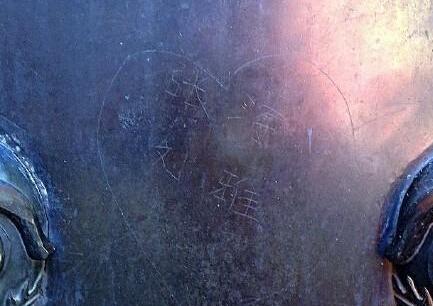
A couple carved their names on a 300-year-old vat at the Palace Museum, stirring widespread discussion online. (File photo)
A netizen wrote on Weibo on Sept 11 regarding a couple's scandalous behavior of carving their names on a 300-year-old vat at the Palace Museum and called for the museum to report the case to the police.
The scandal has incited heated discussion online, most of which are accusations of the uncivilized action of inscribing on ancient relics. Staff at the Palace Museum told the media during an interview that this kind of incident happens all the time and they will submit an official report to the police.
"Zhang Tao, Liu Ya, if you want to publicly display your affection to each other, please go somewhere else. Carving your names on a vat that dates back nearly 300 hundred years is a crime", wrote one raging Weibo netizen called "Zhuanshilijian" on Sept 11.
The netizen claimed that the two names were inscribed inside a heart carved on a bronze vat at the Palace Museum. The informant further pointed that the vat was made during the Qing Dynasty when Emperor Qianlong was in power.
The post stirred a wave of discussion online. Some criticized the offending behavior, saying, "I don't want to visit the Palace Museum only to find relics being carved by immoral tourists." Other netizens said it is commonplace that ancient artifacts in Palace Museum are being defaced and legislation should be introduced.
A staff member of the Palace Museum said that similar incidents take place every year and that the root cause is that the consequence of breaking the law is too low.
People, including emperors and celebrities, have a long history of leaving their handwriting at scenic spots. Their marks are all over China's famous mountains, temples and have even become an essential part of the scenery.
Influenced by this "fashion", ordinary people also learn to mimic the act, though most of their carvings are words like "I have been here", and totally lack any aesthetic value.
Apart from random engravings, the Palace Museum has encountered several cases of scandalous behaviors this year.In March there was news that open-air relics were trampled and in May nude models were photographed riding on ancient artifacts in the museum's courtyard.
Defacing historic relics can have serious consequences, beyond severely damaging the original appearance of the objects and distorting the historic message they carry.
In recent years, with an increasing number of Chinese tourists travelling abroad, inscription scandals can blemish China's national image. (In 2013 a Chinese boy carved his name on a stone sculpture at an ancient temple in Egypt in and stirred widespread reaction worldwide.)
However, these kinds of indecent behavior are not entirely bad, it means that the most urgent issue is to raise people's awareness of protecting cultural relics. It is not only amoral issue but also a legal one and worth relentless efforts from both authorities and ordinary people.


















































